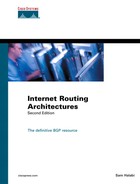Chapter 5. Border Gateway Protocol Version 4
This chapter covers the following key topics:
-
How BGP works— An overview of how the Border Gateway Protocol (Version 4) operates, including its message header format, and how and what it negotiates with neighboring routers. We'll cover the formats and purposes of BGP's four main message types—OPEN, NOTIFICATION, KEEPALIVE, and UPDATE.
-
Multiprotocol extensions to BGP-4— We'll discuss Multiprotocol BGP, which was originally designed expressly for interdomain multicasting but can accommodate other protocols as well.
-
Capabilities Negotiation with BGP-4— BGP Capabilities Negotiation provides a mechanism to cleanly introduce new features to BGP. I'll discuss its operation and then detail some of these features in later chapters.
-
TCP MD5 Signature Option for BGP— The TCP MD5 Signature Option was added to BGP to protect BGP from spoofed TCP segments, particularly TCP resets. I'll discuss its operation and some associated caveats.
The Border Gateway Protocol (BGP) has gone through several phases and improvements since its original version, BGP-1, in 1989. BGP-4 deployment began in 1993. It is the first BGP version that handles aggregation (classless interdomain routing [CIDR]) and supernetting, as discussed earlier in this book.
BGP imposes no restrictions on the underlying network topology. It assumes that routing within an autonomous system is done via an intra-autonomous system routing protocol (Interior Gateway Protocol [IGP]). For the purposes of this book, intra means within an entity, and inter means between entities. BGP constructs a graph of autonomous systems based on the information exchanged between BGP routers. This directed graph environment is sometimes referred to as a tree. As far as BGP is concerned, the whole Internet is a graph of ASs, with each AS identified by a unique AS number. Connections between two ASs together form a path, and the collection of path information forms a route to reach a specific destination. BGP uses the path information associated with a given destination to ensure loop-free interdomain routing. Figure 5-1 illustrates this general path tree concept.
Figure 5-1. Sample AS_PATH Tree

